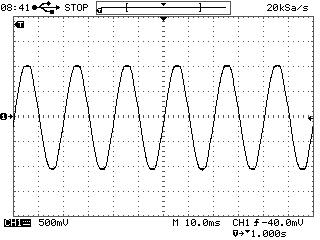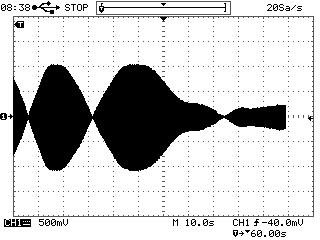| www.tmatlantic.com
Test & Soldering Equipment On-line Store |
|
D.E.V.I.C.E. (Wiki)Calculators Services |
|||||
Filter by first letter
|
AliasingWhen you change horizontal sweep on a digital oscilloscope you can see the waveform changing of the same signal on different horizontal sweeps. It’s important to take into consideration the fact that you work with a digital oscilloscope and it digitizes a signal with different sampling rate depending on the horizontal sweep chosen, and afterwards it connects the digitized points with a smooth line (interpolates them), restores the real signal waveform. Example: You are measuring the mains frequency of 50 Hz at sweep of 10 ms/div with sampling rate of 20 kHz (kSa/s). One signal period (20 ms), digitized in this mode, 20E-03(sec) * 20E03(1/sec) = 400 points. It’s enough to restore and interpolate a sine wave of 50 Hz (i.e. in a period of 20 ms). Normal waveform at 10 ms/div sweep:
Distortion of the same signal waveform at 10 s/div sweep:
On the second display the sweep is set for 10 s/div and the sampling rate at this sweep is 20 Sa/s. That means that for one signal period of 20 ms: 20E-03(sec) * 20(1/sec) = 0.4 points. That is impossible to restore (point by point interpolation) the sine wave having less than one point for the period. Therefore you get aliasing formed by the beating of the frequency under measurement and the sampling rate.
To set data acquisition mode of a digital oscilloscope correctly you should follow a simple rule: its sampling rate should be at least 5-10 times higher than the signal frequency. In this case you will be able to escape any mistakes which can be seen on the second display. All of this concerns any digital oscilloscope and it’s connected neither with its type nor with its probes.Cuando cambia el barrido horizontal en un osciloscopio digital, puede ver cómo cambia la forma de onda de la misma señal en diferentes barridos horizontales. Es importante tener en cuenta que se trabaja con un osciloscopio digital y éste digitaliza una señal con diferente frecuencia de muestreo según el barrido horizontal elegido, y luego une los puntos digitalizados con una línea suave (los interpola), restablece la forma de onda de señal real. Ejemplo: está midiendo la frecuencia de la red de 50 Hz con un barrido de 10 ms/div con una frecuencia de muestreo de 20 kHz (kSa/s). Un período de señal (20 ms), digitalizado en este modo, 20E-03(seg) * 20E03(1/seg) = 400 puntos. Es suficiente restaurar e interpolar una onda sinusoidal de 50 Hz (es decir, en un período de 20 ms). Forma de onda normal con un barrido de 10 ms/div:
Distorsión de la misma forma de onda de la señal en un barrido de 10 s/div:
En la segunda pantalla, el barrido se establece en 10 s/div y la frecuencia de muestreo en este barrido es de 20 Sa/s. Eso significa que para un período de señal de 20 ms: 20E-03(seg) * 20(1/seg) = 0,4 puntos. Eso es imposible de restaurar (interpolación punto por punto) la onda sinusoidal que tiene menos de un punto para el período. Por lo tanto, obtiene un aliasing formado por la superación de la frecuencia bajo medición y la tasa de muestreo.
Para configurar correctamente el modo de adquisición de datos de un osciloscopio digital, debe seguir una regla simple: su frecuencia de muestreo debe ser al menos 5-10 veces mayor que la frecuencia de la señal. En este caso, podrá evitar los errores que se pueden ver en la segunda pantalla. Todo esto concierne a cualquier osciloscopio digital y no está conectado ni con su tipo ni con sus sondas. |
Measurement History Events
|
Site mapPrivacy policyTerms of Use & Store PoliciesHow to BuyShippingPayment




|





























